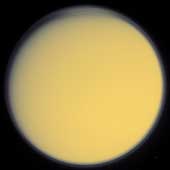|
COMETS EARTH JUPITER KUIPER BELT MARS MERCURY METEORITES NEPTUNE OORT CLOUD PLUTO SATURN SOLAR SYSTEM SPACE SUN URANUS VENUS ORDER PRINTS
PHOTO CATEGORIES SCIENCEVIEWS AMERICAN INDIAN AMPHIBIANS BIRDS BUGS FINE ART FOSSILS THE ISLANDS HISTORICAL PHOTOS MAMMALS OTHER PARKS PLANTS RELIGIOUS REPTILES SCIENCEVIEWS PRINTS
|
Related Documents
Download Options
A global detached haze layer and discrete cloud-like features high above Titan's northern terminator (day-night transition) are visible in this image acquired on October 24, 2004, as the Cassini spacecraft neared its first close encounter with Titan. This full disk view of Titan is a colorized version of the ultraviolet image released on October 25, 2004 (PIA06120). The globe of Titan and the haze have been given colors that are close to what the natural colors are believed to be. The image was acquired at a distance of about 1 million kilometers (621,371 miles) in a near ultraviolet filter that is sensitive to scattering by small particles. The Sun preferentially illuminates the southern hemisphere at this time; the north polar region is in darkness. The well-known global detached haze layer, hundreds of kilometers above Titan's surface, is produced by photochemical reactions and visible as a thin ring of bright material around the entire planet. At the northern high-latitude edge of the image, additional striations are visible, caused by particulates that are high enough to be illuminated by the Sun even though the surface directly below is in darkness. These striations may simply be caused by a wave propagating through the detached haze, or they may be evidence of additional regional haze or cloud layers not present at other latitudes. |
